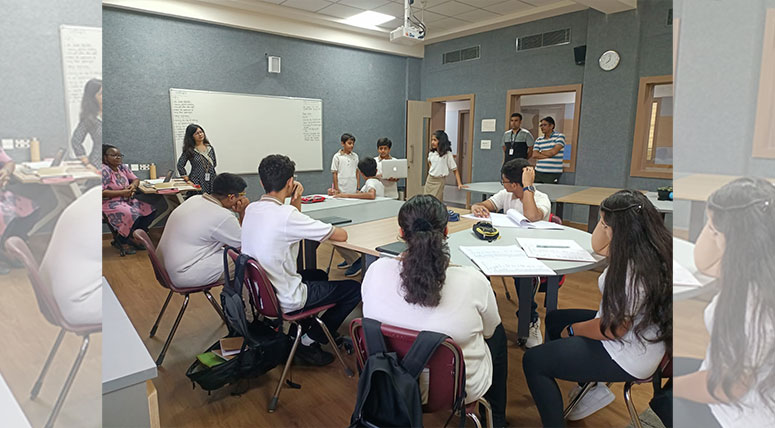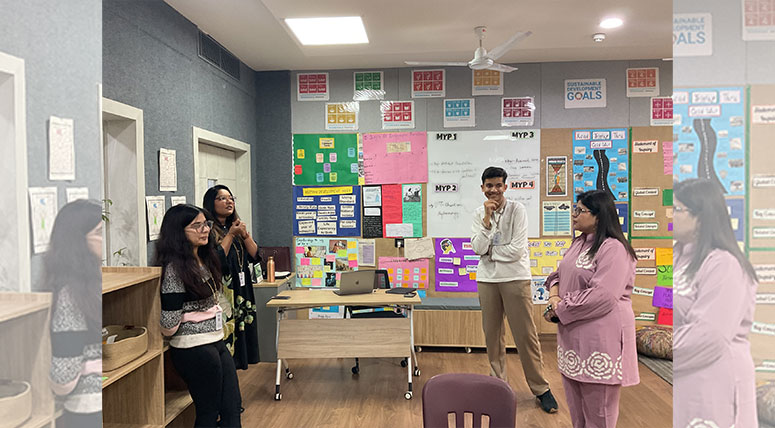THE IB CURRICULUM UNIVERSAL SUCCESS SERIES || CHAPTER 6
The IB education system in India has been flourishing over the years. A major factor contributing to the increase of IB Schools in the country has been the gap between content and skill sets. Manav Rachna International School, Sector 14, Faridabad offers the PYP, MYP and IB Diploma Programmes- the curriculum ensures that students imbibe the IB learners profile attributes to lead the world to a better place.
The IB Diploma Programmeis the last leg of the IB curriculum. This 2 year programme is renowned for its rigorous framework that inculcates critical skills in the students while they learn the content. The curriculum aims to foster critical thinking and global perspectives among students. Through these aspects the curriculum cultivates deep understanding of various subjects among thetop IB Board school students worldwide.
The IB Diploma Programme (which is equivalent to Grade 11 and 12 combined in case of other curriculums), offers six subject groups to IB School students, from which they can choose their subjects along with the level of rigor. The six groups constitute of the following: Linguistics and Literature, Language Learning, People and Societies, Sciences, Maths and the Arts.
Out of these six subject groups, Individuals and Societies plays a vital role as it includes disciplines such as Economics and Business Management. Students engage with key concepts, theories and methodologies relevant to each discipline, enabling them to develop a deep knowledge base.
In this blog we take a deeper look on these two disciplines and how these are aligned with the vision of Manav Rachna International School- the best IB School in Faridabad.

Business Management Overview
The Business Management course of an IB International School, is created to fulfill the demands of students both today and in the future who wish to expand their understanding of business principles, tools, and information in order to help them make business decisions. The need for the future is for employees, business leaders, entrepreneurs or social entrepreneurs to have the skill of being confident, creative and compassionate for business in a global marketplace. The IBDP course, offered by International Baccalaureate Schools, fulfills the above requirement which is designed to encourage the development of these attributes.
Curriculum Alignment with Manav Rachna-IB Vision
The IB curriculum is very well aligned with the high quality learning at Manav Rachna- IB vision which aims to believe in learning as a lifelong journey and promote creativity and making responsible citizens. The curriculum covers four interdisciplinary concepts: Change, Ethics, Creativity and Sustainability. The school believes in “Sustainability drives Globality” and visions to take the future employees, business leaders, entrepreneurs or social entrepreneurs to apply and make the country future ready.
Curriculum Structure
The curriculum is divided into five parts: Introduction of Business Management, Finance, Marketing, Human Resource and Operation Management.
Introduction of Business Management:
It includes ways of business planning that can lead to organizational success.
Finance:
It helps the students to understand how financial reporting can have diverse impacts in a business. It also helps to interpret the financial and accounting practices as a form of sustainable business behavior.
Marketing: It focuses on how the social, cultural and technological changes may have an effect on marketing language and media. It also helps to analyze the marketing practices that can be effective for business success.
Human Resource Management: It aims to understand how people play a role in bringing organizational change. It helps in understanding the human resource systems and how it may positively affect employee performance.
Operations Management:Provides insights into effective business operations and management practices.
Integration and Real-World Application
The course aims in integrating the concepts and content with the help context which will include the real life examples and case studies. To scaffold the case studies the BM toolkit helps to give solutions. The curriculum also aims in making connections with Individuals, businesses and societies. It empowers students to be decision makers and build their 21st century skills.
Course Levels and Assessment Modes
- Standard Level (SL): 150 hours
- Higher Level (HL): 240 hours
The assessment model comprises four criteria:
- Knowing and Understanding: Demonstrates knowledge of business management tools and theories, identifies business problems, and makes informed decisions.
- Application and Analysis:Analyzes business management tools and theories, utilizing relevant data for decision-making.
- Synthesis and Evaluation:Evaluates stakeholder interests and forms informed decisions.
- Application of Appropriate Skills: Communicates analysis, evaluation, and research conclusions effectively.
Internal and External Assessment
Assessments are divided into internal and external components:
- Internal Assessment:Constitutes 30% for SL and 20% for HL, involving a research project on a real business issue or problem.
- External Assessment: Constitutes 70% for SL and 80% for HL, employing analytic mark schemes, mark bands, and assessment criteria specific to each examination paper.
The external assessment has three different methods used to assess students: Analytic mark schemes specific to each examination paper, Mark Bands and Assessment criteria.
In conclusion, the Business Management course at Manav Rachna-IB is taught to equip students with the 21st century necessary skills and knowledge to achieve in a dynamic global marketplace. It focuses on the concepts of Change, Ethics, Creativity, and Sustainability. The curriculum not only works with the high standards of lifelong learning and responsible citizenship but also prepares students to become innovative and ethical leaders. It will strive towards learning with a comprehensive structure that integrates real-life examples, case studies and a robust assessment model.
The IB Education System in India, enables its students to strengthen their capabilities for critical thinking, communicating and decision making. This will have a Rubric structure that will ensure that students are fit for the challenges in the business world and become responsible citizens in society.

Overviewing the Subject ECONOMICS
Economics is the subject which helps the students to develop the understanding of the complexities of interdependent economic activities which are changing rapidly in the current scenario of the world. The IB course deals with the problem of scarcity; where the population needs and wants are unlimited; how the scarcity of limited resources can get solutions with the choicesthat have to be made.
The IBDP Economics course aims at:
- The study of producer and consumer at the market (microeconomics)
- The study of government and national economy (macroeconomics)
- Study of interdependence of countries with international trade (Global economics)
Curriculum Alignment with Manav Rachna-IB Vision
The IB DP Economics Curriculum is very well aligned with the high quality learning at Manav Rachna- IB vision which aims to believe in learning as a lifelong journey and promotes sustainability, all the while making responsible citizens.
The curriculum covers four interdisciplinary concepts: Change, choice, interdependence, intervention, equity, sustainability, economic well-being and efficiency. The school advocates for the idea of ‘Sustainability drives Globality’ and visions to take the future economic agents. The students will have knowledge, skills, values and attitudes that can encourage them to act responsibly as global citizens.
Curriculum Structure
The curriculum consists of four segments: Introduction of Economics, Microeconomics, Macroeconomics and Global Economics.
Introduction of Economics: The Introduction consists of the economics approaches and potential conflicts between economic growth and equity and between free markets and government intervention.
Microeconomics:The unit includes study of consumer and producer choices as the outcome of complex decision-making. Also, governments employ policy instruments that can influence market dynamics, and the instruments work well to some extent in most live markets.
Macroeconomics: It is the discipline that deals with Cyclical movements in economic activity that affects the welfare of people and nations. It also seeks to compare and contrast various macroeconomic theories, point out several reasons and provide various fixes for macroeconomic issues.
Global Economics:It is the study of increased economic integration that may increase productivity, well-being, and financial security, but the advantages could not translate into equal rights.
Integration and Real-World Application
The course aims in integrating the concepts and content with the help context which will include economic theories, models and tools. The curriculum also aims in making connections with Individuals, businesses and societies with the help of real world issues.
Course Levels and Assessment Model Available in 2 Levels:
- Standard Level (SL): 150 hours
- Higher Level (HL):240 hours
The assessment model comprises four criteria:
- Knowing and Understanding: Demonstrates knowledge of Economic tools, theories and different approaches of economists.
- Application and Analysis: Analyzes economics tools and theories, utilizing relevant data for decision-making.
- Synthesis and Evaluation: Evaluates stakeholder interests and forms informed decisions.
- Application of Appropriate Skills: Communicates analysis, evaluation, and research conclusions effectively.
Internal and External Assessment
Assessments are divided into internal and external components:
- Internal Assessment: Constitutes 30% for SL and 20% for HL, involving a research project on a real business issue or problem.
- External Assessment: Constitutes 70% for SL and 80% for HL, employing analytic mark schemes, mark bands, and assessment criteria specific to each examination paper.
The external assessment has three different methods used to assess students: Analytic mark schemes specific to each examination paper, Mark Bands and Assessment criteria.
The external assessment has three different methods used to assess students: Analytic mark schemes specific to each examination paper, Mark Bands and Assessment criteria. ‘
In conclusion, the Economics curriculum in IBDP aims to help students use financial principles, simulations, concepts, and instruments along with data analysis to comprehend and interact with real-world economic issues and problems facing individuals and societies. It enables students to apply their skills to integrate 21st century skills and be responsible citizens. It will develop a conceptual understanding of individuals’ and economic decisions made by societies, their interactions, difficulties, and results.
ALSO READ: PYP Wisdom Wallet: Wise World of Books
ADMISSIONS OPEN FOR IB PYP, MYP & DP AT IB @ MRIS 14, FARIDABAD, GURUGRAM, SESSION 2024-25
Author: Ms. Urvi Yadav, Individuals and Societies Faculty, Manav Rachna International School, Sector 14, Faridabad, IB *Candidate School
